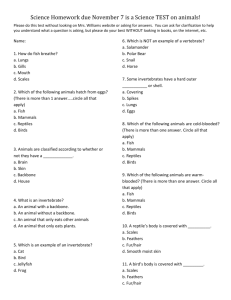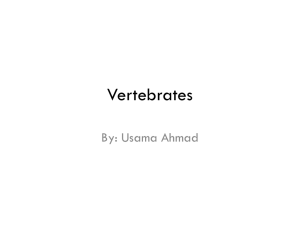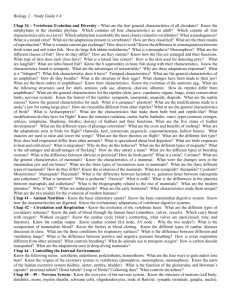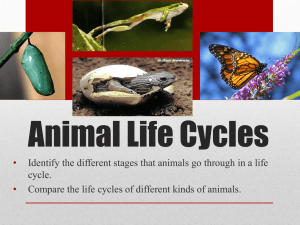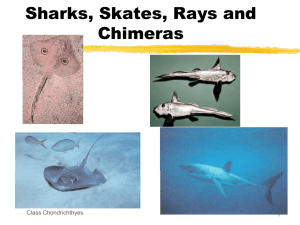Vertebrate Worksheet
advertisement
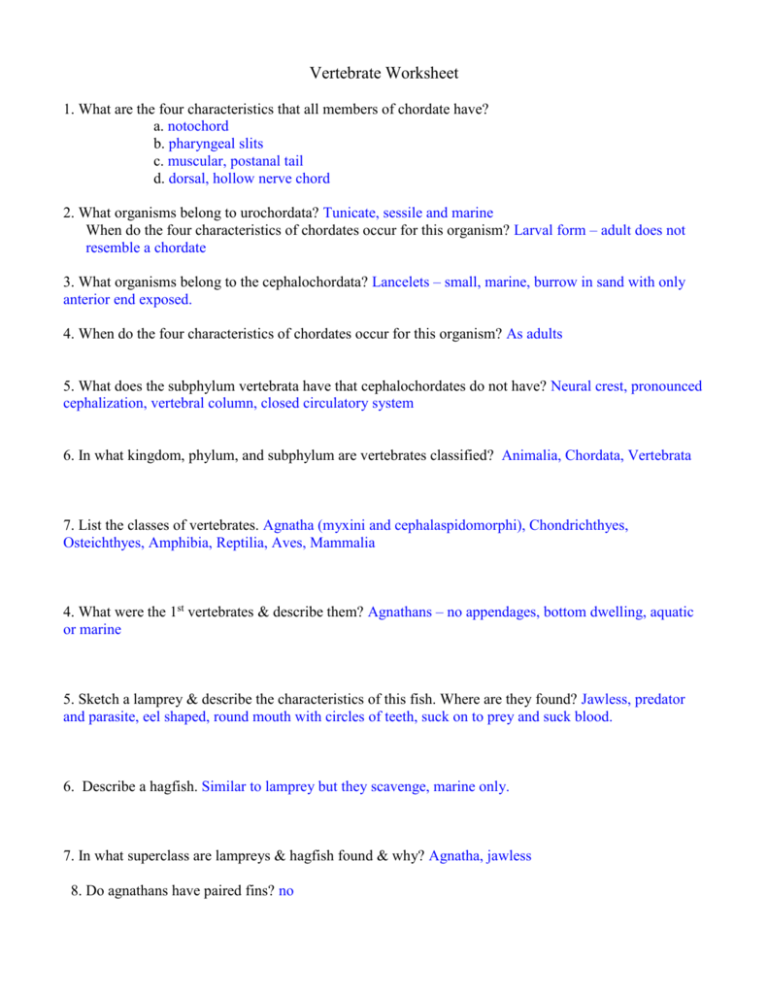
Vertebrate Worksheet 1. What are the four characteristics that all members of chordate have? a. notochord b. pharyngeal slits c. muscular, postanal tail d. dorsal, hollow nerve chord 2. What organisms belong to urochordata? Tunicate, sessile and marine When do the four characteristics of chordates occur for this organism? Larval form – adult does not resemble a chordate 3. What organisms belong to the cephalochordata? Lancelets – small, marine, burrow in sand with only anterior end exposed. 4. When do the four characteristics of chordates occur for this organism? As adults 5. What does the subphylum vertebrata have that cephalochordates do not have? Neural crest, pronounced cephalization, vertebral column, closed circulatory system 6. In what kingdom, phylum, and subphylum are vertebrates classified? Animalia, Chordata, Vertebrata 7. List the classes of vertebrates. Agnatha (myxini and cephalaspidomorphi), Chondrichthyes, Osteichthyes, Amphibia, Reptilia, Aves, Mammalia 4. What were the 1st vertebrates & describe them? Agnathans – no appendages, bottom dwelling, aquatic or marine 5. Sketch a lamprey & describe the characteristics of this fish. Where are they found? Jawless, predator and parasite, eel shaped, round mouth with circles of teeth, suck on to prey and suck blood. 6. Describe a hagfish. Similar to lamprey but they scavenge, marine only. 7. In what superclass are lampreys & hagfish found & why? Agnatha, jawless 8. Do agnathans have paired fins? no 9. What were the 1st jawed fish & describe them. Placoderms – plate skinned, Devonian period (~400MYA) 10. What are the 2 classes of jawed fish? Chondrichthyes and Osteichthyes 11. What is in the class Chondrichthyes & what traits do they have in common. Sharks and rays, cartilaginous skeletons, suspension feeders or carnivores, acute senses, lateral line, internal fert. 12. Compare and contrast: oviparous, ovoviviparous, and viviparous. Oviparous: Eggs laid in protective coat, hatch outside mom’s body; ovoviviparous: Fertilized eggs develop within mom, young born after hatching in uterus; viviparous: young develop in uterus not in egg, live birth. 13. What is the function of the following: a. Swim bladder – buoyancy, can be modified lung b. Lateral lines – sense changes in water pressure, detects vibrations c. Keratinized scales – tough for protection, waterproof, slime to reduce drag d. Operculum – flap over gills, push water out – allowing fish to breathe without moving. e. Cloaca – one opening for urine, feces, and reproduction 14. Name the class for bony fish. Osteichthyes 15. Name the 2 subclasses of bony fish. Actinopterygii – ray-finned fishes and Sarcopterygii – lobefinned fishes and lung fishes 16. Give several examples of ray-finned fish & describe them. Trout, salmon, bass 17. Name 2 lobe-finned fish & describe both of them. Coelocanths and rhipidistians – muscular pectoral and pelvic fins. Can “walk” on fins. Only 1 extant species, a coelacanth. 18. What was the 1st group of vertebrates to move onto land? What is in this group? Amphibia – frogs, toads, salamanders 19. Define tetrapod. What is the link between fish and tetrapods? Tetrapods walk on 4 legs. A Devonian lobe-finned fish is the likely link. 20. Describe characteristics of amphibians. “2 lives” tadpole – frog. Metamorphosis. Tied to water – no shell on eggs, mostly external fertilization. 21. Amphibians are ectotherms. What does this mean? Cold-blooded 22. How are amphibians still linked to water? Eggs, fertilization 23. Name and describe the 3 extant orders of amphibians. Urodela – salamanders, Anura – frogs and toads, Apoda – Caecilians (legless, burrowing) 24. What is in the class Reptilia? Turtles, snakes, lizards, crocodiles, alligators 25. Reptiles do not need water for reproduction. Explain why this is true. Amniotic egg 26. Sketch an amniotic egg. What are the four key extraembryonic membranes in an amniotic egg and the function of each? A Amnion – protection, fluid filled to cushion and hydrate B Allantois – wastes, gas exchange C Chorion – gas exchange D Yolk sac – covers the yolk, a stockpile of nutrients for the devel. embryo 27. Describe characteristics of the reptiles. Ectothermic, keratinized scales, lungs, amniotic egg, mostly internal fertilization 28. What reptile group is thought to be the ancestors of mammals? Synapsids – mammal-like reptiles 29. What were pterosaurs? Flying reptiles, existed with dinosaurs 30. What 3 orders of retiles are still alive today? What are the main differences between the 3 orders? Chelonia – turtles, Squamata – lizards and snakes, Crocodilia – alligators and crocodiles. 31. What class contains birds? Aves 32. From what did birds probably evolve? Explain the evidence. Flying reptiles – amniotic egg and scales on feet. 33. What are the distinguishing features of birds? Honeycomb bones, absence of teeth, only 1 ovary, endothermic, feathers, air sacs, amniotic egg, wings, keeled sternum 34. Explain the concept of an airfoil and how it allows flight in birds. Air traveling over airfoil has to travel farther > molecules spaced farther apart than below airfoil > greater pressure below airfoil > lift. 37. Birds are endotherms. What does this mean? Warm-blooded – use their metabolic heat to maintain a constant body temp. 37. Explain how a bird wing is adapted for flight. Honeycomb bones, hollow feather shaft, aerodynamic stiff contour feathers 38. What adaptation do carinates have for flight? Keeled sternum – bone for super-muscle attachment in the chest 39. What characteristics differentiate mammals from the other vertebrate classes? Hair, diaphragm, subcutaneous fat, mammary glands, placenta, differentiated teeth 40. What in female mammals produces milk? Mammary glands 41. What is mammalian hair made of and what are its functions? Keratin – temperature regulation, camouflage, behavior 42. What bones are modified in mammals to help them hear sounds? Lower jaw bone 43.Give examples of monotremes & tell their characteristics. Tell where they are found. Platypuses, echidnas, lay eggs, no nipples, suck mild from fur of mother. Australia 44. Give examples of marsupials & tell their characteristics. Tell where most of them are found. Kangaroos, opossums, koalas, embryonic devel. Completed in pouch. Mostly in Australia. 45. Most mammals are placentals. What does this mean? Eutherian – lining of mom’s uterus and other membranes membranes help nutrients diffuse into embryo’s blood, long-lasting association between mother and developing young 46. What is gestation? Do all mammals have the same gestation period? Pregnancy – condition of carrying embryo(s). Rodents = 21 days, dogs = 60 days, humans ~ 270 days, elephants = 600 days 47. What is the purpose of the chorion? delete 48. Name the 12 orders of placental mammals & give an example of an animal in each order. Artiodactyla – sheep, carnivore – bears, cetacean – whales, chiroptera – bats, edentata – sloths, insectivore – shrews, lagomorpha – rabbits, perisssodactyla – horses, primates – monkeys, proboscidea – elephants, rodentia – mice, sirenia - manatees 49. Which group of primates is most closely related to us? chimpanzees 50. List five hominids in order from most primitive to Homo sapiens and give one sentence describing them. A. Gibbons – long tail, acrobatic, monogamous B Orangutan – solitary, live in trees C Gorilla – largest ape, herbivores, Africa D Chimpanzees, trees and ground, intelligent, closely related to humans E Humans 51. Which model on the origins of humans would say that we all have a common ancestor of “Lucy” or some other African human? Give one piece of evidence that supports this idea and one piece of evidence that refutes this idea. Monogenesis model says we all came from common African ancestor, Multiregional model says humans in different continents evolved independently. For monogenesis: only African fossils show the complete transition from archaic Homo sapiens to modern humans Against monogenesis: Some fossils from various continents that could be links between archaic Homo sapiens and modern humans.




